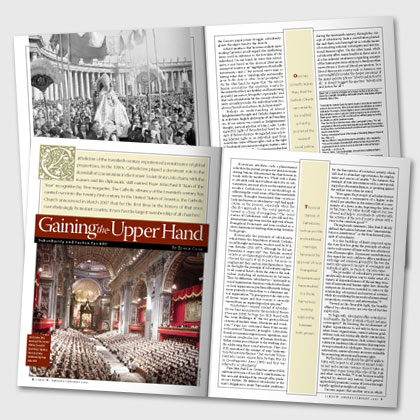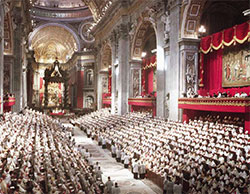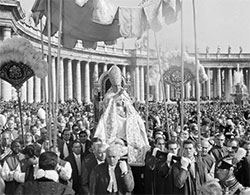Gaining the Upper Hand
Edwin C. Cook January/February 2009
Catholicism of the twentieth century experienced a renaissance of global proportions. In the 1990s, Catholicism played a dominant role in the downfall of Communism in the former Soviet Union. His charm with the masses and his diplomatic skill earned Pope John Paul II “Man of the Year” recognition by Time magazine. The Catholic vibrancy of the twentieth century has carried over into the twenty-first century. In the United States of America, the Catholic Church announced in March 2007 that for the first time in the history of that once overwhelmingly Protestant country, it now has the largest membership of all churches.1
Historians attribute such a phenomenal rebirth to the pivotal, progressive decisions made during Vatican II that moved the church more in touch with the modern era. While such a claim is certainly valid and evidence exists for its substantiation, one may also trace the exuberance of modern Catholicism to its methodology in addressing the social issues of the late nineteenth century. Principles formulated then—particularly one known as subsidiarity—still find application in the present, especially when the church’s approach to “the social question” is viewed as a form of evangelism.2 The social stances of Catholicism, such as pro-life and traditional marriage, have won the approval of most Evangelical Protestants and have resulted in a closer, harmonious working relationship between both groups.
Historically, the principle of subsidiarity, which forms the foundation of much Catholic social thought and action, was first used by W. E. von Ketteler (1811-1877), although he did not formulate it expressly.3 Von Ketteler viewed society as an organological entity that not only stressed the unity of all its parts, but more so emphasized their mutual interdependence. Seen in this light, the principle of subsidiarity applies to all societal factors, from the state to the individual, including all institutions in between. Thus, by definition, subsidiarity is “a principle in social organization: functions which subordinate or local organizations perform effectively belong more properly to them than to a dominant central organization.”4 It presupposes the state to be of divine origin and that society is correctly viewed from an organological perspective.5
 The October 1962 opening of the Second Vatican Council at Saint Peter's Basilica. The Council was summoned by Pope
The October 1962 opening of the Second Vatican Council at Saint Peter's Basilica. The Council was summoned by Pope
John XXIII .
Von Ketteler’s seminal concept of subsidiarity was later enunciated in the encyclical Rerum Novarum (1891) by Pope Leo XIII. Faced with the social challenges of “the two great political systems of modern times, liberalism and socialism,”6 Pope Leo criticized them from newly rediscovered Thomistic principles. Liberalism found its economic expression in capitalism, and socialism resulted in loss of human freedom. Either system posed threats to the working class. By addressing these social injustices, Pope Leo XIII introduced the concept of state “intervention- but-not-interference” that was later formulated into a more concise form by Pope Pius XI in Quadragesimo Anno (1931) and that was referred to as subsidiarity.7
Pope John Paul II, in Centesimus annus (1991), celebrated 100 years of Leo XIII’s contributions in this area and developed the concept of his predecessors further. He defined subsidiarity as the state’s obligation to create “favourable conditions for the free exercise of economic activity, which will lead to abundant opportunities for employment and sources of wealth.”8 He balances this example of state intervention with a corresponding policy of noninterference, as speaking against the welfare state, when he stated:
“Here again the principle of subsidiarity must be respected: a community of a higher order should not interfere in the internal life of a community of a lower order, depriving the latter of its functions, but rather should support it in case of need and help to coordinate its activity with the activities of the rest of society, always with a view to the common good.”9
Through such statements, John Paul II clearly defined the balance between state “interventionbut- not-interference” as the foundational principle of subsidiarity.
It is this backdrop of limits imposed upon the state that has given the principle of subsidiarity such universal fame in the area of international human rights. Its primary contribution in this regard lies in its ability to offer a medium of exchange and common ground for the two diametrically opposed concepts of sovereignty and individual rights. As Paolo G. Carozza states:
“The principle of subsidiarity provides an analytically descriptive way to make sense of a variety of disparate features of the existing structure of international human rights laws, from the interpretive discretion accorded to states, to the relationship of regional and universal systems, while also justifying the necessity of international cooperation, assistance, and intervention.”10
Viewed in this favorable light, the benefits offered by subsidiarity are worthy of further exploration.
To begin with, subsidiarity offers several practical benefits, the first of which is that it restrains sovereignty.11 By limiting the involvement of higher organizations to aid only in those cases when lower organizations cannot achieve goals without such aid, it naturally checks overinvolvement of larger organizations. Such action is highly salutary in modern political systems that empower strong nationalistic ideologies. Since it tempers nationalism, universal norms are more realizable for promoting international human rights.
Furthermore, subsidiarity has global applicability with respect to all political (except totalitarian) and economic systems. Since it takes an “ambivalent stance toward the roles of the state and other social bodies,”12 it can be more readily adopted by almost any nation. Such general applicability promotes a sense of justice through equally applied principles of action.

Pope John XXII is carried ceremoniously to Saint Peter’s Basilica for the inauguration of the Second Vatican Council, October, 1962.
Carozza argues that another area in which subsidiarity offers a new vista to social justice is its support for pluralism in human rights discourse. By its very nature, the principle of subsidium focuses upon the individual and his or her freedom that is directed from a larger organization toward him or her. In this schema, the rights of the individual to develop as a person are strengthened and enhanced through the facilitation provided by the organization above him or her. Viewed in this light, subsidiarity is personalistic; “its first foundation is a conviction that each human individual is endowed with an inherent and inalienable worth, or dignity, and thus that the value of the individual human person is ontologically and morally prior to the state or other social groupings.”13 Rather than detracting from social justice, it is more readily obtained.
Although subsidiarity has much to offer, it has weaknesses in several areas. First, it endangers church-state relations. By definition, subsidiarity is designed to limit, or even to restrict, state involvement, which concept poses no threat in itself. The corollary of subsidiarity, however, requires higher organizations to facilitate the functioning of lower organizations. By such an ordering of societal structures, it naturally lends itself to supporting a theory of nonpreferential government aid to religious institutions.
This point bears significant weight in light of John Paul II’s statements against the modern welfare state. If the welfare state is viewed as “an evil to be avoided,” then responsibility for societal needs falls upon the shoulders of lower organizations, such as nonreligious and religious groups dedicated to caring for the needy. Rather than the state taking direct charge of caring for its citizens, it should aid those subsidiary organizations (religious bodies) through monetary support to accomplish such fraternal duties as caring for the disadvantaged of society.
Furthermore, one must consider the historical context of the origin of the principle of subsidiarity. The Roman Question was still far from being resolved in the late nineteenth century. Leo XIII, who first introduced the premise of limiting the state in Rerum Novarum , marked his episcopate as one dedicated to the liberty of the church.14 Thus, through the concept of subsidiarity, strong, modern nation-states are limited from overinvolvement with those areas that the church identifies as traditionally belonging to its care; yet, by the same principle of subsidiarity, the state is obligated to assist the lower organizations to fulfill their mission, where such assistance may sometimes take the form of monetary sustenance. In simplistic terms, in the Caesaro-papal power struggle, subsidiarity grants the upper hand to the church.
A third weakness that becomes evident upon reading Carozza’s article regards the conflicting terms used in reference to the freedom of the individual. On one hand, he states that subsidiarity is not based on the classical libertarian concept of society as an “aggregation of radically autonomous units,” but instead views man as having value that is “ontologically and morally prior to the state or other social groupings.”15 On the other hand, he argues that “the various human associations that constitute society (to the extent that they are healthy and functioning properly) are seen to fit together organically ,” and that such a foundation for the concept of subsidiarity actually provides the individual with freedom to flourish and achieve his full potential.16
Perhaps an understanding of liberal Enlightenment thought and Catholic dogmatics is in order here. English philosophy of the Founding era of our nation was rooted in Enlightenment thought, particularly that of John Locke. Locke argued for rights of the individual based on concepts of the law of nature. He regarded man as having inherent rights as an individual apart from societal ties. Some of these rights, such as the right to freedom of conscience in religious matters, were considered as inalienable, meaning no individual can relinquish such rights to any other person, or even to the state. Thus, Locke’s Enlightenment thought argued for rights of the individual.
From a Catholic perspective, freedom for man means he has liberty to pursue truth and the good.17 More than this, he is actually obligated to enquire after the truth. Such notions find resonance only against the backdrop of an objective moral order, implying an underlying normative base, whether it is natural law or eternal law. Since the Catholic Church defines itself as the authoritative interpreter of either of these laws,18 then it is the final arbiter in queries concerning truth and the good. Part of its mission, in modern democratic societies, is to facilitate the adoption of Catholic moral thought by engendering discussion and debate within the body politic to achieve the common good as its ultimate end.19 Thus, it is correct to state, as Carozza does, that from a Catholic perspective, an individual has freedom within the concept of subsidiarity. However, from a liberal perspective this amounts to restrictions of conscience by attempting to bring the individual into conformity with the common good of society as defined by Catholic moral theology.
One may correctly argue, then, that the Catholic Church can certainly be credited as having promoted the cause of social justice, especially during the nineteenth century, through the concept of subsidiarity. Such a contribution planted the seed that is now bearing fruit as a viable means of reconciling national sovereignty and international human rights. On the other hand, while subsidiarity offers many benefits in these areas, it also has inherent weaknesses regarding concepts of the human person in relation to freedom when viewed from a classical liberal perspective. In a liberal democratic society such as America, one may insightfully ponder the deeper meanings of the quaint patriotic phrase “Liberty and justice for all,” or should I suggest the question “Subsidiarity and justice for all”?
- Technically, the Catholic Church has had the largest membership among denominations in America since the 1850s, if denominational sub-affiliations are counted individually. For example, Southern Baptist members counted distinctly from National Baptist members resulted in Catholics being the majority of either two Baptist groups. However, in 2007, even when all sub-affiliated groups are totaled, the Catholics are still the dominant majority.
- Pope John Paul II , in Centesimus annus, article 5, paragraph 6, states, “The ‘new evangelization,’ which the modern world urgently needs and which I have emphasized many times, must include among its essential elements a proclamation of the Church’s social doctrine.”
- Ad Leys, Ecclesiological Impacts of the Principle of Subsidiarity (Kampen: Uitgeverij Kok, 1995), p. 25.
- Merriam-Webster’s Collegiate Dictionary, Eleventh Edition, entry “subsidiarity.”
- “Because the principle of subsidiarity fits within the wider framework of the organological vision of society, we must describe both versions of that larger framework.”—In Leys, p. 14.
- Ernest L. Fortin, “Sacred and Inviolable: Rerum Novarum and Natural Rights,” Theological Studies 53 (1992): 207.
- Paolo G. Carozza, “Subsidiarity as a Structural Principle of International Human Rights Law,” American Journal of International Law 97, no. 1 (Jan. 2003): 41.
- John Paul II , Centesimus annus, article 15, paragraph 5.
- Ibid., article 48, paragraph 4.
- Carozza, p. 40.
- Ibid., p. 52.
- Ibid., p. 44.
- Ibid., p. 42.
- John Courtney Murray, “Leo XIII : Two Concepts of Government,” p. 561. Retrieved March 20, 2007 from www8.georgetown.edu/centers/Woodstock/library/ Murray/1953d.htm; Thomas F. Stransky, Declaration on Religious Freedom of Vatican II (New York: Paulist Press, 1966), p. 138.
- Carozza, p. 42, emphasis mine.
- Ibid., p. 43, emphasis mine.
- John Paul II , Centesimus annus, article 46, paragraph 4: “But freedom attains its full development only by accepting the truth.”
- “[Natural law] points to God as the lawgiver, and it threatens to bring up for public discussion the claim of the Catholic Church that the Pope, as the Vicar of Christ, is the authoritative interpreter of the natural law” (Charles E. Rice, 50 Questions on the Natural Law: What It Is and Why We Need It [San Francisco: Ignatius Press], p. 33).
- The post-Reformation political structure of nation-states that are not perceived as being of divine origin, nor a part of an organic universal system, but that are constitutionally based, has posed a challenge to the church, especially when those constitutions grant freedom for all religions, or, as in the case of Communism, for no religion. In light of such modern political structures, the church states: “Wherefore We . . . address all civil rulers and all those who are in any way in charge of public affairs, and We solemnly assert that the Church must always enjoy a due freedom, in order to pursue her work of education, to impart truth to the mind, to impress justice on the spirit, and to refresh both mind and spirit with the divine love of Jesus Christ” (Pope Pius XII , Summi pontificatus, 1939, as cited by John Courtney Murray, in Religious Liberty: Catholic Struggles With Pluralism [Louisville, KY : Westminster/ John Knox Press, 1993], p. 168). This same concept, of freedom for the church from state restrictions, was emphasized again in the highly acclaimed document Dignitatis humanae (Declaration on Religious Freedom) of Vatican II (1965).
Article Author: Edwin C. Cook
Edwin Cook has a doctorate in church-state studies from Baylor University, Waco, Texas. He writes from Waco.